How we remember them: Celebrating the life of a friend who died
In New Orleans, a silversmith’s friends celebrated their life with a party and the knick-knacks they left behind.
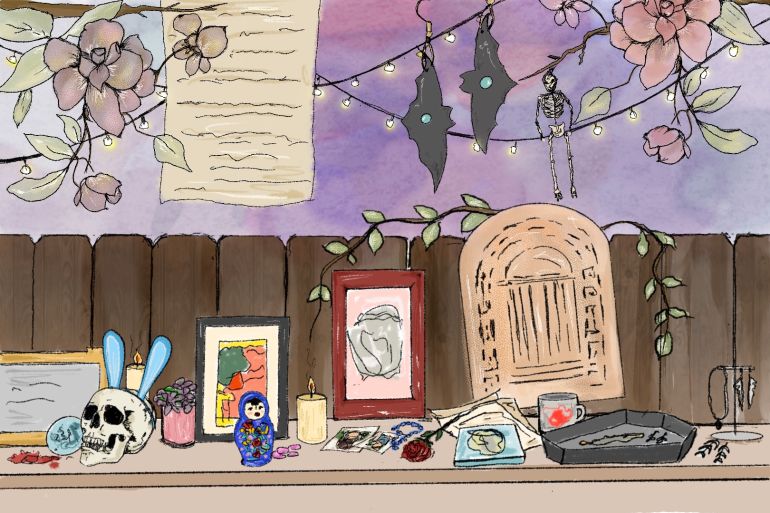
Warning: This story contains references to suicide. If you or a loved one is experiencing suicidal thoughts, help is available. Visit Befrienders Worldwide for more information.
New Orleans, United States – Luke Crowther’s friendship with Sleepy Hickham began like this: They were the two most awkward people in the room.
Keep reading
list of 4 itemsHow we remember them: My sister’s tea basket
How we remember them: A garden of memories in Mumbai
Lost to Alzheimer’s: Losing Mom but finding her magic cheesecake
About six years ago, they were at a Christmas party for the high-end jewellery designer Mignon Faget, where Sleepy worked along with Luke’s wife. Luke noticed Sleepy standing off to the side, still in braces, anime tattoos peeking out from under their sleeves. “It’s like we were at the kids’ table. They said, ‘I don’t fit in with these people.’ And I was like, ‘I’m just here because my wife brought me.’ And we sat and talked about video games all night,” he recalls.
But quiet and unobtrusive isn’t really how Luke and another good friend, John Preston, remember Sleepy. They were more mischievous than that. Instead, the two remember a rainy November night in 2018, out in the Louisiana woods with friends, all from a club that role-played skirmishes with BB guns and armour.
They remember Sleepy, giddy with drink and flirting with their new crush. Wrestling their helmet on, imbued with what Luke calls Sleepy’s “devilish joy”, demanding to duel John.
They remember Sleepy driving 13 hours north to visit the parents of their best friend and roommate, Emily McDonald, where they saw snow for the first time since childhood. Sleepy, in a video, plunged through fresh powder, doing a funny sideways crab-hop in a knee-length olive coat, throwing snow in the air and singing, “I love it! So fluffy!”
They remember Sleepy at an all-you-can-eat buffet, eating the “nastiest deep-fried sushi” they could find just to horrify their friends.
These are the Sleepy stories that Luke and John trade on a warm June evening, sitting at a tiny sidewalk table in downtown New Orleans, drinking beers and occasionally bickering over the details. They, along with Emily, were some of Sleepy’s closest friends, and if Sleepy were there, they’d be quibbling with them, too.
“Sleepy was very debaucherous in a very innocent way,” John said, smiling as he spoke. “Sleepy was a true sweetheart.”
On May 19 last year, Sleepy, a beloved trans silversmith in New Orleans, took their own life while at home. They were 26.
Saving for the future
Kaito “Sleepy” Hickham grew up in River Ridge, a quiet suburb two bridges upriver from New Orleans, in a conservative family. That was hard on Sleepy even as a child. When they were about 10 years old, their parents told them they weren’t allowed to wear a favourite t-shirt because it had a lizard on it, and therefore was “a shirt for boys”.
Their family sent them to Ursuline Academy, the oldest “all-girls” Catholic school in New Orleans. “From what I know they were pretty out there then, too,” Luke said, meaning that Sleepy never tried to tamp down facets of themself. “Openly bisexual in school,” Luke says, “had no problem being out to teachers.” They got facial piercings and tattoos starting at 14.
Sleepy was pragmatic about their parents’ conservatism and tried to maintain a good relationship with them even after they moved out at 18 to attend college.
About a year later, they began making jewellery; when they were briefly forced to move back in with their parents, they kept making jewellery out the back of the house, melting down metal with an acetylene torch and figuring out alloy compositions.
They loved their work. Sleepy, a moniker that came from “SleepyTaurus”, an old gaming username, had been expanding their jewellery-making business even after COVID hurt sales and forced them to pick up a full-time job in shipping, says Emily. They wound up loving the job, which let them work with heavy machinery. “Getting forklift certified was a major point of pride for them,” Emily adds.
Sleepy worked so hard, in fact, that Emily worried. “Sleepy struggled with financial anxiety. They worried about basic month-to-month finances in a city where [the] cost of living continues to rise exponentially while wages have stagnated,” she says.
They sometimes lamented that their busy life didn’t leave them time for travel, pets, or hobbies. They even gave away their two fish tanks and almost all their houseplants last year during a period of overwhelming stress.
They wanted to start saving for their future. “Independence was very important to Sleepy,” Emily says.
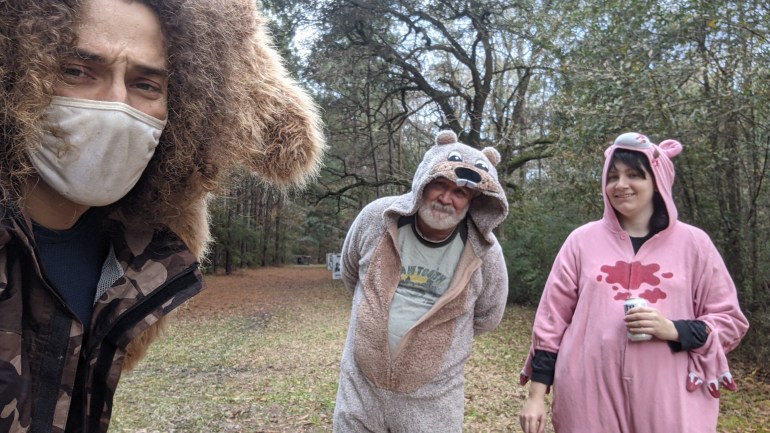
‘Talk through their laughter’
Despite these worries, Sleepy was the kind of person “to talk a lot through their laughter,” says John. “Sleepy was always a very big social butterfly. Their outward-facing personality was so boisterous and enjoyable 90 percent of the time,” Luke says.
“You knew what Sleepy was thinking, you knew how Sleepy felt, all the time,” John says. “Sleepy would have strange earrings, they’d dress in a way that was eye-catching.”
But the exuberance itself was driven by a desire to be accepted, Luke believes. He wonders if Sleepy invited judgement about their clothes and taste as a kind of litmus test for how people would react to their gender identity.
Sleepy knew they identified as they/them or he/him for a long time, says Luke.
“Back in 2016, 2017, even when they were still presenting very femme, with long hair and dresses, they were still very clear: I don’t identify as female,” says Luke.
Sleepy “had trouble getting some people to use “they/them” pronouns,” says Emily.
At the BB club – “90 percent dudes” with many of them in their 60s and 70s, Luke says – members would frequently misgender Sleepy. But as with their parents, Sleepy aimed to keep the peace; they never wanted to bring it up. “I don’t think people are going to get it,” Sleepy would say to their friends.
So John began using a different name for each of the club’s war games. “Finally, I told the other guys: if you can remember to call me a different name each week, then you can remember to call Sleepy by their proper pronouns.”
Dozens of men in the Louisiana woods can be an intimidating scene, but Luke thinks that, on some level, Sleepy “revelled in it.” He thinks “the acceptance they found in the BB club” was what they were missing from the male role models in their family. After Sleepy’s death, members of the BB club constructed a memorial for them in the woods where they used to skirmish.
When the family held a funeral, Luke walked out. He says it memorialised someone he didn’t really know – Sleepy of the Ursuline Academy school uniform, of good behaviour in River Ridge.
Sleepyfest was how their friends celebrated Sleepy’s life instead.
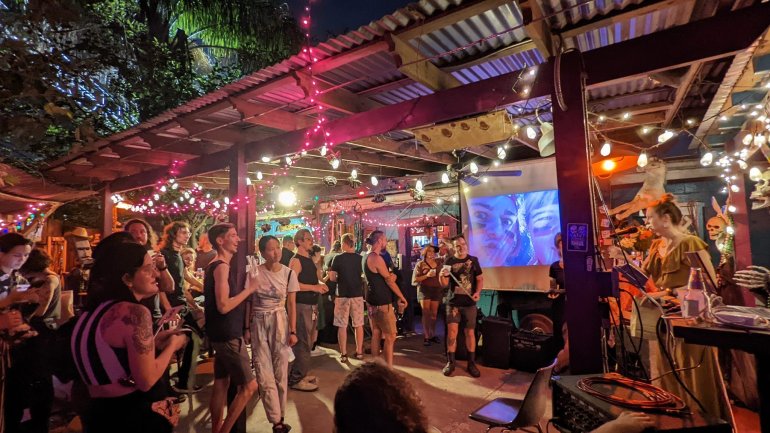
Sleepyfest
When Sleepy was alive, “Sleepyfest” was supposed to be their birthday party, one that made up for celebrations that didn’t happen due to COVID or venue problems.
John, Luke, and Emily began planning Sleepyfest soon after they heard the news.
While cleaning out Sleepy’s room, Luke, his wife Corey, and Emily “looked for iconic Sleepy things,” little tokens of their personality. Books about smithing, about melting down what’s precious to make something new were all over, along with the accumulated detritus of a life.
“We didn’t know what to do with those things,” Luke remembers. “There’s no value, we can’t sell that stuff. How do I sell a Budweiser mouse mat? Or an anime figurine that has weird stains on it? It means nothing. But it means something to people that see that and identify Sleepy as a person from that.”
On June 18, Sleepyfest was held at Bar Redux, tucked into the crook where an industrial canal hits the Mississippi River. Along the back wall, Sleepy’s friends lined a 20-foot (six-metre) shelf with Sleepy’s tchotchkes and knick-knacks, and encouraged guests to take something they’d find meaningful: a Hello Kitty alarm clock, tiny bottles of perfume, black plastic bats, a 3D-printed rainbow lizard, stickers, buttons, Sleepy’s doodles and more.
On another table, Emily printed out more than 400 photos and stickers of Sleepy for anyone to take, and stacked bowls of their favourite brand of extra spicy instant ramen (Buldak). “Sleepy caught what we assume was COVID in March 2020, leaving them with [a] limited sense of smell and taste, which prompted an interest in spicy foods,” says Emily. Nearby, on a rack, Sleepy’s clothes, free to a good home: a hoodie with a hand-sewn BLM patch, a neon orange cat-patterned onesie Emily gave Sleepy for Christmas.
“Cleaning out the apartment my best friend died in was one of the harder things I’ve been a part of in my life, but it was cathartic to see the comfort and joy that their belongings brought to others who were grieving,” Emily says. “It felt right to send the things that Sleepy loved home with the people Sleepy loved.”
Emily saw friends alternate between laughing and crying as they dug through Sleepy’s collection of oddities and recalled the stories they went with.
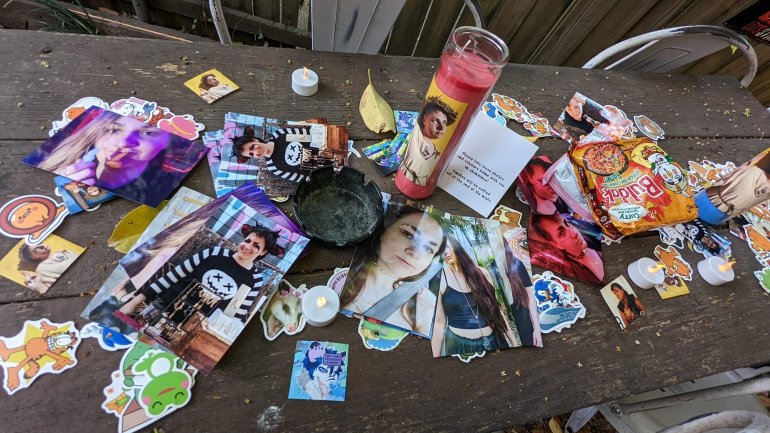
Honoured by a recurring party
About 100 friends came to Sleepyfest. A huge range of people called Sleepy a friend, from mohawked punks to old country men from the BB club, a cross-section of creative misfits.
Sleepy was part of a community of makers, many of whom donated some 50 creations to be sold at a raffle for a dollar per ticket. Emily, also an artist, made what she called the “Saint Sleepy prayer candle” which came in two variations – one with Sleepy in their Virgin Mary Mardi Gras costume, and the other in their Jesus Mardi Gras costume. “While Sleepy wasn’t religious, they loved to play creatively with the holy iconography they grew up around. The dichotomy of male and female images also felt fitting to celebrate a nonbinary person who spent the last year of their life exploring their gender identity and pushing the boundaries of their own presentation,” says Emily.
Local artists contributed paintings, prints, jewellery, an enormous beaded dreamcatcher, a hand-sewn doll, and more for the raffle. Emily says a couple of artist pals made free custom “party favours,” like handmade stud earrings that looked like tiny fried eggs to celebrate Sleepy’s favourite comfort food, or holographic stickers of a drawing of Sleepy.
Luke says it probably helped many in their grieving process to be involved in Sleepyfest, something they want to put on every year.
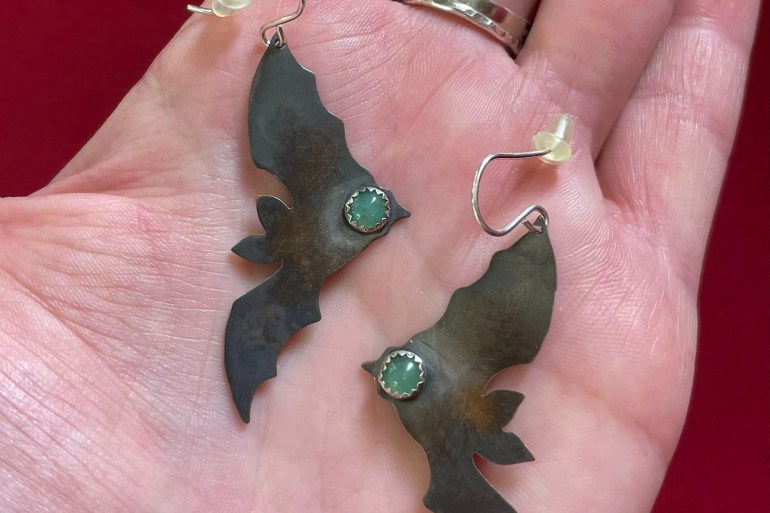
“Sleepy would love being glamourised by a drunk party that recurs over and over again,” he says. “I think that’s very fitting.”
And it was a party. People sang and danced in the clothes Sleepy sang and danced in. John’s band and others played. Attendees could get possum face-painting, since possums were a favourite animal of Sleepy. At Sleepy’s funeral, Luke had worn a suit; at Sleepyfest, he wore a t-shirt with Bart Simpson on it.
They all kept Sleepy treasures: Luke brought home the “shark in a jar,” a pickled fetal shark. Sleepy, he says, had stolen it from one of the biology classrooms at Ursuline Academy.
John got Sleepy’s Mardi Gras costume: a toy baby’s head and arms attached to a headpiece, a mutant baby. “Sleepy would call it their ‘child’,” John says. “So I have a picture on my fridge of Sleepy with the baby, and I have that costume, because it was peak Sleepy weirdness type stuff.”
Emily kept Sleepy’s Doc Martens and one of the frog-eye headbands that she and Sleepy recently wore. The matching amphibian crowns were the result of Emily cashing in a birthday gift that Sleepy gave her: a handwritten IOU. “Tickets to the aquarium at a time of your choosing, so we can look at frogs together,” she recalls the IOU read. “If I’d known Sleepy would die four days later, I would have taken a picture of us in our frog headbands that day. But we were too busy enjoying the frogs.”
After Sleepyfest, Emily sold Sleepy’s leftover jewellery. There’s a sterling silver ribcage, dangly copper earrings with they/them pronouns, brass and onyx bats on hooks, a pendant in the shape of ghosts. Through Sleepyfest and the sale of jewellery Sleepy left behind, Sleepy’s loved ones raised $3,000 for House of Tulip, a New Orleans organisation that creates housing solutions for trans and gender-nonconforming youth. Emily also donated a lot of Sleepy’s tools and materials to their old jewellery-making instructor, “so new students could use Sleepy’s things to learn the craft from Sleepy’s mentor.”
Bravery and joy
In March, in a post left pinned to the top of their Facebook page, Sleepy wrote, “Being feminine has always felt like a performance or costume for me. Sometimes that’s okay, because I like costumes, but it’s never genuine. I just want to live my life authentically and be seen.”
“What I admired about Sleepy,” John says at the end of the night on the sidewalk, growing quieter, “was their bravery. Sleepy put it all out there. For everyone … Most of us, as we get older, we get more guarded.”
“Sleepy could experience highs and lows like very few people,” says John. The lows, now, seem obvious, he says. But he adds that that is why it is so good, so important, to remember that “Sleepy was also capable of a tremendous amount of joy.”
Watching the video Emily took of a giddy Sleepy skipping through a snow-filled yard at night is the first time John says he cried. “You see Sleepy experience this level of joy. And you remember that’s the person they were, too.”
If you or someone you know is at risk of suicide, these organisations may be able to help.
In the US, the National Suicide Prevention Lifeline is 988.
Also, in the UK and Irish Republic, contact Samaritans on 116 123 or email jo@samaritans.org.
For those bereaved by suicide in the UK, contact Survivors of Bereavement by Suicide.
In Australia, the crisis support service Lifeline is 13 11 14.
Other international suicide helplines can be found at www.befrienders.org